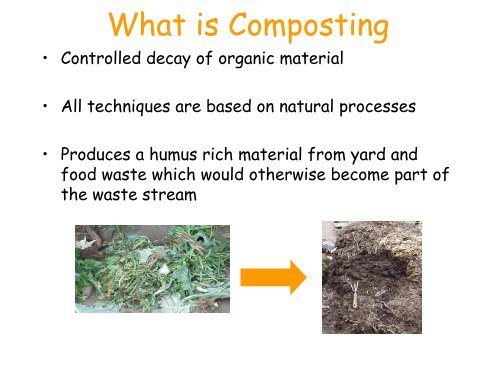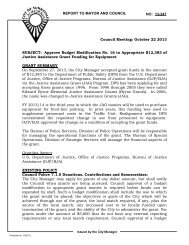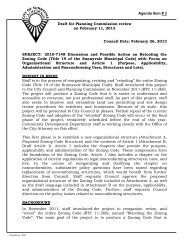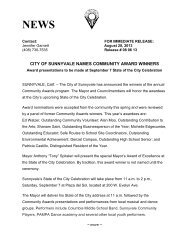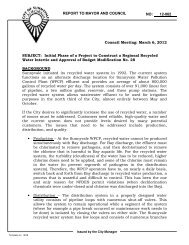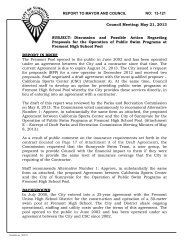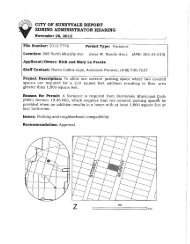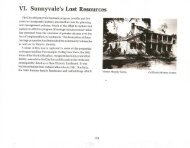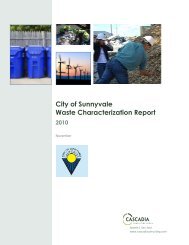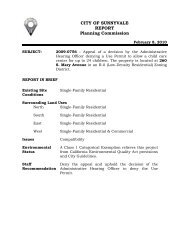Backyard Compost - City of Sunnyvale
Backyard Compost - City of Sunnyvale
Backyard Compost - City of Sunnyvale
You also want an ePaper? Increase the reach of your titles
YUMPU automatically turns print PDFs into web optimized ePapers that Google loves.
What is <strong>Compost</strong>ing<br />
• Controlled decay <strong>of</strong> organic material<br />
• All techniques are based on natural processes<br />
• Produces a humus rich material from yard and<br />
food waste which would otherwise become part <strong>of</strong><br />
the waste stream
<strong>Compost</strong>ing is one step in an<br />
ongoing backyard process<br />
Plant growth<br />
and production<br />
Incorporate into soil<br />
as soil amendment<br />
resulting in healthier<br />
plants<br />
Natural<br />
Cycle<br />
Pruning and<br />
harvesting<br />
<strong>Compost</strong>ing <strong>of</strong><br />
waste
Why <strong>Compost</strong>?<br />
• Reduces landfill pressures<br />
– Source reduction, Move to Zero Waste<br />
• Makes environmental sense even if your<br />
city has a yard waste composting program<br />
• Produces a wonderful soil amendment<br />
– improves soil structure<br />
– reduces watering needs<br />
• It’s fun and rewarding<br />
– wholesome exercise
Types <strong>of</strong> <strong>Compost</strong>ing<br />
• Grasscycling<br />
– leave lawn clippings on the lawn<br />
•Mulching<br />
– spread yard waste under plants<br />
• <strong>Backyard</strong> Pile<br />
• Vermicomposting (worms)<br />
• more….
Grasscycling<br />
• Leave grass clippings on lawn<br />
• Mulching mower best<br />
• Mow dry, no more than 1/3 <strong>of</strong><br />
total grass blade height<br />
• Does not cause thatch<br />
‣Clippings are 75%<br />
water by weight<br />
‣The rest is a nitrogen<br />
rich (green) material<br />
‣Such a shame to<br />
throw it away<br />
• Reduce waste<br />
• Provides needed nitrogen to lawn<br />
• Supplies organic material to soil
<strong>Backyard</strong> <strong>Compost</strong> Pile
Ingredients <strong>of</strong> a <strong>Compost</strong> Pile<br />
•GREENS- Nitrogen rich materials<br />
•BROWNS- Carbon rich materials<br />
• AIR (fluffed like a salad)<br />
– aerobic composting<br />
• WATER (wrung out sponge)<br />
• Nature provides the organisms<br />
• Time – patience
Greens and Browns<br />
GREENS (C:N < 30:1)<br />
Immature plant material<br />
•kitchen scraps<br />
•(vegetable 12:1, fruit 30:1)<br />
•grass clippings (20:1)<br />
•c<strong>of</strong>fee grounds (20:1)<br />
•cow, poultry, rabbit, horse manure<br />
•none from meat eating animals<br />
•vegetable garden wastes<br />
•live plant pruning<br />
BROWNS (C:N > 30:1)<br />
Mature, woody plant material<br />
•Leaves (40-60:1), naturally fallen<br />
•Corn and sunflower stalks<br />
•Dead plants/pruning<br />
•Straw (100:1)<br />
•Pine Needles (70:1)<br />
•Shredded Paper (170:1)<br />
•Wood chips, Sawdust (400:1)<br />
•no plywood or pressure treated
Material to avoid<br />
• Cat or dog feces<br />
• Meat or dairy food wastes<br />
– egg shells are welcome in the pile<br />
• Hard to control material<br />
– Bermuda grass, Bind weed (wild morning glory)<br />
– Ivy, unless it is finely chopped<br />
• Wood ashes<br />
• Plants treated with herbicides<br />
• Use Oleander only in a hot pile<br />
• Thorny plants unless shredded
Organisms<br />
• Psychrophilic: 0 o F to 55 o F - low temp<br />
• Mesophilic: 70 o F to 90 o F - middle temp<br />
• Thermophilic: 104 o F to 170 o F - high temp<br />
Aerobic Bacteria<br />
Fungus<br />
Actinomycete<br />
Worm<br />
Nematode<br />
Mite<br />
Springtail<br />
Ant<br />
Sow Bug
Building a <strong>Compost</strong> Pile<br />
•Use 50% GREENS and 50% BROWNS by volume<br />
•Chop the material if you want it to break down faster.<br />
• Wound for a cold pile<br />
• Chop to ½” to 1 ½” for a hot pile<br />
•Build the pile in layers or mix together<br />
•Mix GREENS and BROWNS<br />
OR<br />
•3” <strong>of</strong> GREENS<br />
•3” <strong>of</strong> BROWNS<br />
•Water<br />
•Repeat<br />
•Add water as required (as moist as a wrung out sponge)
Hot <strong>Compost</strong>ing<br />
• “Build all at once” compost pile.<br />
• Ideal hot compost pile needs:<br />
– > 1 cu. yd. <strong>of</strong> material. (3’ x 3’ x 3’)<br />
– Material chopped ½” – 1 ½”.<br />
– 50-50 greens/browns mix.<br />
• > 140F potentially – It’s the bacteria!<br />
– Thermophilic bacteria.<br />
– Kills most weed seeds and plant disease pathogens.<br />
– <strong>Compost</strong> fast (2-3 months or faster)<br />
• More labor to keep ideal air & water conditions<br />
– Turn every 1-2 weeks
Cold <strong>Compost</strong>ing<br />
• “Add as you go” compost pile<br />
– Add material as it becomes available (no minimum)<br />
– 50-50 greens/browns as much as possible<br />
• Food scraps mix with browns into center <strong>of</strong> the pile<br />
– Chop material as much as desired. Chopping will:<br />
• Reduce volume <strong>of</strong> material<br />
• Help speed decomposition => reduces volume<br />
• Temperature is cool to warm<br />
– Weeds seeds and plant disease pathogens survive.<br />
– <strong>Compost</strong> slower (6-18 months)<br />
• As much labor as you want.<br />
– Turn 1-2 months or pile too dry or too wet.<br />
Nothing wrong with either method...<strong>Compost</strong> Happens!<br />
Demo
• Open pile (no bin)<br />
– can be used for hot composting<br />
• <strong>Compost</strong> Bin<br />
<strong>Compost</strong> Piles<br />
– A bin can keep a pile neater<br />
– If food scraps are to be added to a cold pile, then<br />
use rodent pro<strong>of</strong> bin<br />
– A bin with minimum volume <strong>of</strong> 3’x3’x3’ is required<br />
for hot composting
Examples <strong>of</strong> <strong>Compost</strong> Piles<br />
For sale from<br />
Santa Clara County<br />
For sale from<br />
<strong>Sunnyvale</strong>
Tools<br />
• Chop the materials<br />
– chipper shredder<br />
–lawn mower<br />
– weed eater<br />
–hand cutters<br />
– Meat cleaver on old stump<br />
• Maintain the pile<br />
– thermometer (fun)<br />
– turning fork (hot)<br />
–aerator(cold)<br />
•Bins
Harvesting the <strong>Compost</strong><br />
•A Hot pile is done with little or<br />
no heat being produced<br />
• Material has turned dark brown<br />
and original materials are no<br />
longer identifiable (sight and<br />
smell)<br />
• Screening can be used to<br />
remove large not decomposed<br />
items mainly in cold piles<br />
– Build your own screen
Using <strong>Compost</strong><br />
• Improves soil structure by adding<br />
humus and micro organisms<br />
– A soil conditioner<br />
– Top soil restoration<br />
– Soil inoculant<br />
• Typical Applications<br />
– Incorporate in soil prior to planting<br />
– Amend potting mixes<br />
– Mulch or “top dress” planted areas<br />
– Liquid extract<br />
–<strong>Compost</strong> Tea
One teaspoon <strong>of</strong> good garden soil to<br />
which compost has been added contains<br />
• 100 million bacteria<br />
• 800 feet <strong>of</strong> fungal threads
<strong>Compost</strong> as a Mulch<br />
Saves water<br />
Nutrient reservoir<br />
pH Buffer<br />
Results in healthier plants
Incorporating <strong>Compost</strong><br />
Bare Soil<br />
<strong>Compost</strong> Added<br />
Partial Incorporation
Healthy Soil<br />
Yields a<br />
Healthy Garden


